
Ducati Diavel Service Manual: Starter motor
Power: 0.7 Kw/12 v
Direction of rotation: counter clockwise viewed from power take-off side.
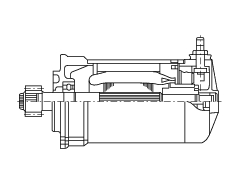
The starter motor is highly compact and reliable and therefore rarely gives any type of problem. In case of troubles, ensure that the starter motor cable terminal is properly tightened under the nut and shows no oxidation. If the terminal is properly tightened and free from corrosion, remove the starter motor and test it under no-load conditions (no load applied to the shaft). Secure the starter motor to a test bench, making sure you do not damage the casing. Use a fully charged 12 v battery for the test. Use battery-motor connection cables which are no longer than 70 cm and with the same cross-section as the cable on the motorcycle itself. Connect the negative terminal of the battery to an unpainted area of the starter motor casing and the positive terminal to its electrical terminal. The shaft of the starter motor should rotate freely and at high speed. Take care not to short-circuit the two cables connected to the battery.
Removing the starter motor
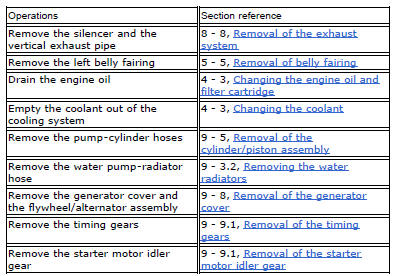
Remove the fixing screw (1) and, if necessary, the insert (2).
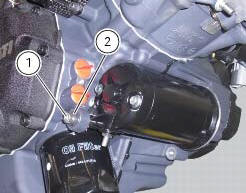
Unscrew the fixing screws (3): the lower screw (3) fixes also the ground cable (6). Collect the toothed washer (7) and the washer (8).
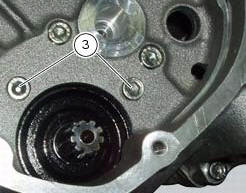
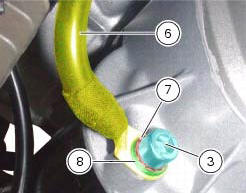
Note
The starter motor retaining screws are assembled with threadlocker.
Slide out the starter motor and gasket (5).
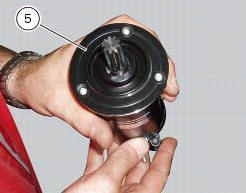
Refitting the starter motor
Inspect the condition of the gasket (5) and renew if necessary.
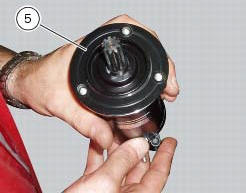
Position the gasket (5) and the starter motor on the crankcase. Start the retaining screws (3) with recommended threadlocker; the lower one (3) with the ground cable (6), the toothed washer (7) and the washer (8). Tighten the retaining screws (3) to a torque of 10 nm (min. 9 Nm - max. 11 Nm) (sect. 3 - 3, Engine torque settings).
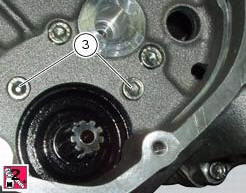
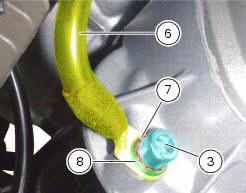
Locate the insert (2) (if removed) in the crankcase half, hand tighten the fixing screw (1) and tighten it to a torque of 10 nm +/- 10% (sect. 3 - 3, Frame torque settings).
Place the starter motor/solenoid starter cable (4) and tighten the retaining nut to a torque of 5 nm +/- 10% (sect. 3 - 3, Frame torque settings).
Important
Fill the cap with protective grease before fitting it on the starter motor.
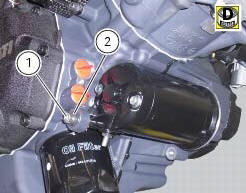

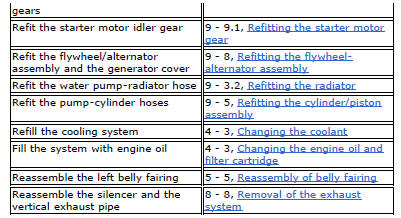
 Electric starting system
Electric starting system
Note
The references of the elements listed below are those of the "wiring
diagram", sect. 6 -1.
Electric starting system
The key components of the electric starting system are a solenoid (6) and ...
 Solenoid starter
Solenoid starter
Remove the protection cover (a).
Undo the screws (2), taking care to collect the spring washers (3).
Remove the starter motor-solenoid cable (4) and the solenoid-battery cable (5).
Remo ...
Other materials:
Overhauling the front forks
Note
It is advisable to loosen the top cap (14) when the fork is still fitted
to the motorcycle.
Note
The specific tools for the revision of the fork, are described in sect. 3
- 4, Specific tools for the frame.
Loosen the spring preload adjuster before unscrewing the plug (14).
Unscrew th ...
Engine start button
Introduction
The engine start button is located on the right hand handlebar switchgear set
and is used to turn the engine on.
Component assembling position
The engine start button is included in the switchgear set on the right hand
handlebar.
Location of right hand handlebar switchge ...
Useful information for safe riding
Warning
Read this section before riding your motorcycle.
Many accidents are the result of the inexperience of the
rider. Always make sure you have your licence with you; you
need a valid licence that entitles you to ride a motorcycle.
Do not lend your motorcycle to persons who are
inexperie ...